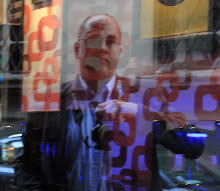The morning started bright and clear and we, in small groups, went outside to sit down in the small courtyard under the vines for breakfast.
Venice is so quiet.
The loudest sounds you will hear are motor boats delivering produce or other articles to stores; vaporetti, if you're near the lagoon, or are on the Grand Canal; bells tolling out the hours; people talking and laughing together while sitting and having a drink. Don't forget your earplugs when you go.
The sun was warm and the air was cool and we made our way over to the Accademia. They have a new ticket booth outside. I found this out by walking right past the three signs directing you to it, inside where you used to buy tickets, watched the people in front of me get directed outside and then asked to buy tickets. A little embarrassing. I spent extra time with the early paintings by Bellini that are in the second room, a bit more time looking and discussing the renamed Feast at the House of Levi by Veronese, and, as always, with the Pieta', Titian's last work. Giorgione's The Tempest used to be in one of the first rooms you go through, now it's along the back hallway (near the bathrooms) in a couple of rooms that are very small and the small paintings in these rooms are hung very close together. In these two rooms are a number of paintings that would be the centerpiece of almost any museum in the world. Here they are inches apart- POW-POW-POW.
The Accademia is overwhelming in what it contains as far as amazing work, but it is not a huge museum. It is easier to look selectively, with less guilt, and avoid Stendhal's Syndrome. A couple students were with me to visit St. Ursula, as I always do. Besides seeing the story by Carpaccio unfold, there is a charm to seeing multiple events taking place on one canvas divided by a column, a wall or a flag. The viewer is transported from the left, where they see an imaginary view, to the right side with the meeting of the Prince and Princess with a backdrop of Venice. But, when looking at Carpaccio's work, as I've written before, I enjoy seeing how the composition is like an interlocking puzzle with one piece meeting another, that piece then framing and leading to another, from mast to flag to column to street to person to facade. There is also the sense that you are going to walk outside right into that world because your view of the buildings and canals do not seem all that different from Carpaccio's.
We went over to the Ponte Rialto to do some drawing, but by now the storm clouds were rolling in and it was only a matter of time before they would let loose. The bridge was relatively uncrowded for the second day in a row as we sat down near the water's edge. In time it started to rain lightly so we moved to the shelter of an open loggia near the old fish market to draw. As one draws the view, your eyes move and recognize shapes, lines and connections. The lines on the paper follow. Up the side of the building, connecting to the roof line of the adjacent palazzo, down the edge of light marble in the face of the building, along the bottom of the window traced out in oriental design, over to the edge of the next building, down to the riva, the bank along the canal.
When we were through I decided to let everyone have free time to explore for hours before dinner. The rain came down a bit harder as the students headed out in groups, to look for something to eat, to take photos, to look for presents to bring back. Walking back through the narrow streets to Dorsoduro the clouds opened and the rain came down in buckets. Standing in the relative shelter of an overhang of a building I stood and watched the shapes, lines, architectural elements interlock with the people racing by, trying not to get soaked, and those, like me, stock still under the awnings.
Saturday, July 17, 2010
Subscribe to:
Post Comments (Atom)

Thank you kindly, Brian. On my list for the next visit: Accademia!
ReplyDelete